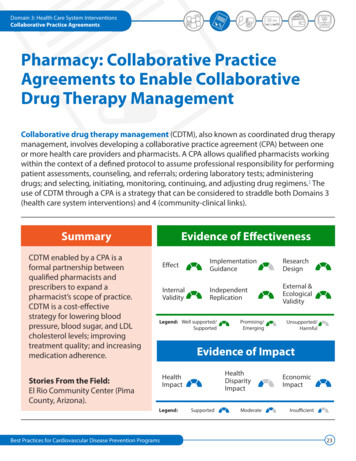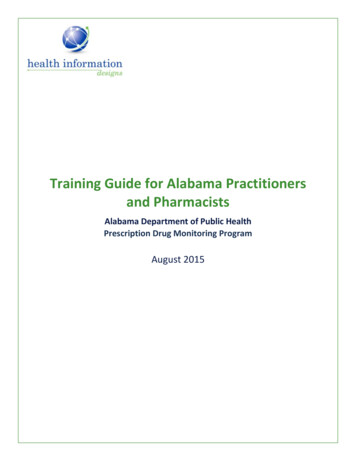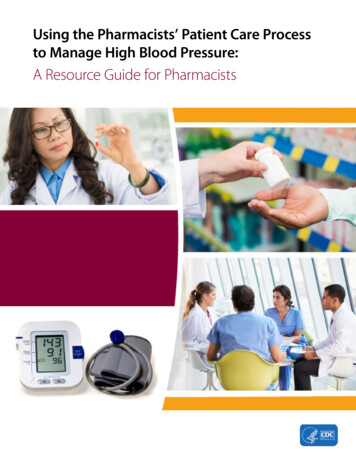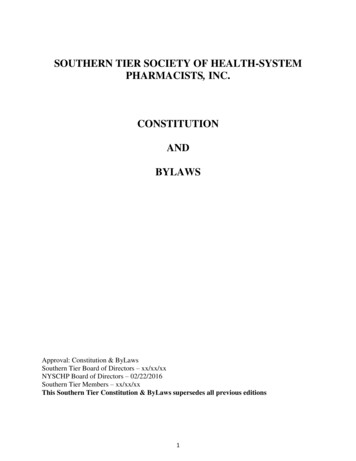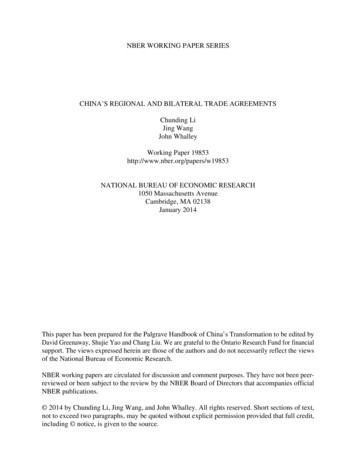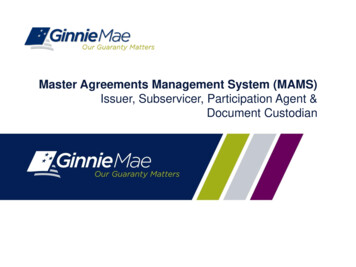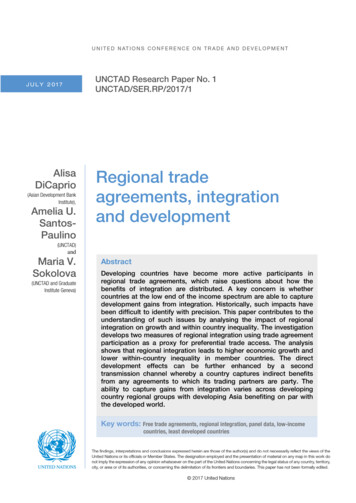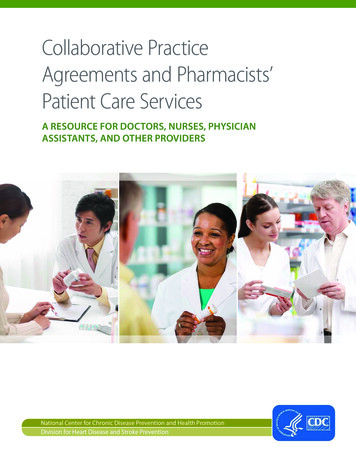
Transcription
Collaborative PracticeAgreements and Pharmacists’Patient Care ServicesA RESOURCE FOR DOCTORS, NURSES, PHYSICIANASSISTANTS, AND OTHER PROVIDERS
COLLABORATIVE PRACTICE AGREEMENTS AND PHARMACISTS’ PATIENT CARE SERVICES A RESOURCE FOR HEALTH CARE PROVIDERSPharmacists can improve patients’ health and thehealth care delivery system if they are part of thepatient’s health care team. One way to achieve thisgoal is with a collaborative practice agreement (CPA)between pharmacists and other health care providers.1Patient care services provided by pharmacists can reducefragmentation of care, lower health care costs, and improvehealth outcomes.1 A 2010 study found that patient healthimproves significantly when pharmacists work with doctorsand other providers to manage patient care.2 The CommunityPreventive Services Task Force also found strong evidence thatteam-based care can improve blood pressure control when apharmacist is included on the team.3States regulate pharmacists’ patient care services through“scope of practice” laws and related rules, including boardsof pharmacy and medicine regulations. Depending on eachstate’s laws, pharmacists can work with other health careproviders through CPAs to perform an array of patient careservices (Figure 1).In January 2012, the American Pharmacists Association (APhA)Foundation brought together a group of 22 national subjectPharmacist CollaborativePractice Agreement (CPA)A formal agreement in which a licensed provider makesa diagnosis, supervises patient care, and refers thepatient to a pharmacist under a protocol that allows thepharmacist to perform specific patient care functions.matter experts to identify evidence for effective policies,practices, and key supports and barriers to expanding the roleof pharmacists in delivering patient care services and enteringinto CPAs.4Consistent with the findings of the Office of the ChiefPharmacist 2011 Report to the U.S. Surgeon General,1 thegroup found that broad access to patient care services delivered by pharmacists is limited by policy and compensationbarriers. The group proposed several strategies for expandingpharmacists’ patient care services through team-based careand CPAs.4 Health care providers can use these strategiesto build and strengthen partnerships with pharmacists toimprove patient care.Figure 1. Map of States with Laws Explicitly Authorizing Pharmacist Collaborative Practice Agreements, 2012Note: Physician delegation is considered permissive in MI and WI, allowing physicians andpharmacists to enter into CPAs.-1-
COLLABORATIVE PRACTICE AGREEMENTS AND PHARMACISTS’ PATIENT CARE SERVICES A RESOURCE FOR HEALTH CARE PROVIDERSStrategies for Advancing Pharmacists’Patient Care ServicesTerms Used to Describe Pharmacists’Patient Care ServicesCreate and expand an infrastructure thatembeds pharmacists’ patient care services andcollaborative practice agreements into care,while creating ease of access for patients.Medication Therapy Management (MTM): A distinctservice or group of services that optimizes therapeuticoutcomes for individual patients. MTM includes five coreelements: medication therapy review, personal medication record, medication-related action plan, interventionand/or referral, and documentation and follow-up.6Pharmacists’ patient care services, including those providedthrough CPAs, can reduce fragmentation of care and improvehealth outcomes if they are set up properly.1 Infrastructurethat embeds pharmacists’ patient care services into currentcare processes and public education initiatives could helppatients understand the services available to them. Processesmay need to be changed within different practice settingsto integrate pharmacists. Components of this infrastructureand associated process changes include the practice model,business model, and patient education (Figure 2).Collaborative Drug Therapy Management (CDTM): Acollaborative practice agreement between one or moreproviders and pharmacists in which qualified pharmacists working within the context of a defined protocolare permitted to assume professional responsibilityfor performing patient assessments, counseling, andreferrals; ordering laboratory tests; administering drugs;and selecting, initiating, monitoring, continuing, andadjusting drug regimens.7Figure 2. Infrastructure and Process Changes to Integrate Pharmacists’ Patient Care ServicesPractice ModelEffective implementation of CPAs.Referrals for pharmacists’ patient care services.Well-informed medical and pharmacy teams.Meaningful communication between providers.Patient EducationEducation on the potential for collaborativecare with pharmacists.Use of every channel to distribute messagesand generate public support for pharmacists’patient care services.Expectation for collaboration on the health careteam.Business ModelScalable: Implementation and paymentmechanisms that work in different practicesettings, creating market-driven care delivery.Sustainable: Payers investing in the resourcesneeded to provide high-quality, integratedpatient care.Profitable: Providers gaining the financialability to focus on providing prevention, patienthealth, and disease management services whilecontrolling health care costs.-2-
COLLABORATIVE PRACTICE AGREEMENTS AND PHARMACISTS’ PATIENT CARE SERVICES A RESOURCE FOR HEALTH CARE PROVIDERSCase Example: IowaOsterhaus Pharmacy in eastern Iowa provides immunizations to patients through CPAs with MaquoketaFamily Clinic, a local medical group of family practice doctors and nurse practitioners. The pharmacyalso provides MTM services to eligible Medicaid andMedicare Part D beneficiaries with chronic diseases.MTM services are provided through informal agreements with Maquoketa Family Clinic and another localclinic, Medical Associates of Maquoketa. To develop aneffective process, the pharmacy created practice andbusiness models that highlight the benefits of formalcollaboration for those involved and build on existing informal relationships. For example, as part of theimmunization protocol, pharmacists educate patientsabout their eligibility for these services by telephone, inperson, or by fax, depending on which method is mostconvenient for the patient. The pharmacist administersthe immunizations according to the terms of the CPA,documents these services in the pharmacy system, andcommunicates this information to the doctor as agreed.Osterhaus Pharmacy’s staff believe this business modelis sustainable because immunizations and MTM servicesare reimbursed by many private and public insurers.5Allow the health care providers who enterinto the collaborative practice agreementto define the details of each agreement.Many successful collaborative relationships develop andevolve as pharmacists and other providers grow to trusteach other.1 As this trust grows, providers can modify CPAs toensure that local partnerships are meeting patients’ needs.Successful CPAs include the following components:Established local relationships.Trust between providers that establishes the scope of collaboration and privileges.Demonstrated competence at providing services and sharing information from patient interactions.Commitments from all providers to provide the bestpatient care possible.CPAs that are written, executed, reviewed, and renewedaccording to the terms set between the collaboratinghealth care professionals.Determinations by different types of providers of the best waysto set up these agreements and overcome local challenges.CPAs that allow all providers to practice to the fullest extentof their licenses when they work together.Case Example: MinnesotaIn the early 1980s, Goodrich Pharmacy, a locally ownedcommunity pharmacy in Minnesota, began enteringinto medication substitution agreements with local doctors. With the adoption and evolution of MTM servicesin the 1990s, Goodrich expanded to five sites aroundthe Twin Cities by 2010. The pharmacy now providesextensive MTM and patient care services through CPAsfor chronic disease care and patient education with theAnoka River Way Clinic.Use simple, understandable, andempowering language when referring topharmacists’ patient care services.Different terms can be used to describe similar patient careservices provided by pharmacists. Simple terms can promoteunderstanding and help create meaningful CPAs that includepharmacists’ services in routine patient care.Pharmacists’ clinical capabilities include the following:Steve Simenson, president of Goodrich Pharmacy,stated that “patient-focused collaborative care hasimproved as a result of closer relationships that weestablished with other health care providers.” Two tothree patients are referred for MTM services each day.The majority of patients participate in the Universityof Minnesota’s employee health plan, UPlan, whichprovides MTM services at no cost to eligible patients.According to Simenson, university officials supportefforts to improve employee health, and they recognizepharmacists’ contributions to better MTM services.11,12Communicating and collaborating with doctors and otherprescribers to provide patient care.Improving the quality of medication management andhealth outcomes.2Improving public health outcomes.3-3-
COLLABORATIVE PRACTICE AGREEMENTS AND PHARMACISTS’ PATIENT CARE SERVICES A RESOURCE FOR HEALTH CARE PROVIDERSTo help make CPAs and the team-based care approach anintegrated part of health care practice,Case Example: ArizonaProviders and student health professionals need educationabout the value of team-based care.Students who work on interdisciplinary teams should betaught how to work with other health professionals toimprove patient care.Since 2000, Arizona law has authorized CPAs betweenpharmacists and doctors in specified health facilities(ARS §32-1970 [A–D]). The law was amended in 2011 bySenate Bill (SB) 1298 (Ariz Sess Laws Ch 103 [2011]) toallow pharmacists in any setting to enter into CPAs withdoctors and nurse practitioners.Pharmacists at El Rio Community Health Center8 haveworked with local doctors since 2000. El Rio is the largestlocal provider of medical services to uninsured andMedicaid patients in Pima County. Each pharmacist andprovider negotiates the terms of the CPA to allow thepharmacist to care for patients with diabetes, high bloodpressure, and high cholesterol. Compared with otherhealth centers, El Rio reports lower costs, more screenings,and fewer emergency room visits among its patients.9Case Examples: Pharmacist-ProvidedCare for Controlling Diabetes, HighBlood Pressure, and High CholesterolThe Asheville Project, the Patient Self-ManagementProgram for Diabetes (PSMP), and the Diabetes Ten CityChallenge (DTCC) were efforts by self-insured employersto provide education and mentoring for employees withchronic health problems such as diabetes, high bloodpressure, and high cholesterol. Patients were enrolled incollaborative care programs that included a communitypharmacist on their health care team.14–18 When the programs were assessed, researchers found the followingbenefits:SB 1298 allowed health care providers at El Rio to setup CPAs without changing their diabetes care protocol.It removed requirements to renew CPAs annually orobtain Board of Pharmacy approval for each protocol. ElRio staff found this change reduced the administrativeburden and cost for pharmacists and providers. The newlaw also removed a requirement for a separate CPA foreach health condition for each individual patient. Thischange allows pharmacists to work more efficiently withother providers to provide care to patients with multiplechronic conditions.10Savings on Overall Health Spending Asheville:Average net savings of 1,622– 3,356 perperson per year.14,15 P: Average net savings of 918 per person peryear.16DTCC: Average net savings of 1,079 per person per year.17,18Examine and redesign health professional scope ofpractice laws, education curricula, and operationalpolicies to create synergy, promote collaboration,and make the best use of support staff.Improved Patient HealthTo make the best use of all providers on a health care team,different health professions can work together to examine andrevise scope of practice laws. For example, in 2009, to reduceworkforce shortages, Pennsylvania officials authorized changesin the scope of practice laws for nurses, physician assistants,and other licensed health care providers to allow them to practice to the full extent of their licensure and training.13If properly written, scope of practice laws can create an environment that can lead to successful CPAs and interdisciplinaryteams, allowing all professionals to practice at the top of theirlicenses and allowing support staff to take on more roles asappropriate.1 Laws, education, and policies can foster theintegration of pharmacists and the services they provide intoteam-based care models. Asheville:50% average reduction in number of sick14,15days.PSMP: 100% of study participants had their gly cosylated hemoglobin (A1C) level tested; 94%of patients met the Health Plan Employer DataInformation Set (HEDIS) goal of 7% or less for A1C.16DTCC: A1C and screening rates improved to 97%; 91% of patients achieved an A1C level that met theHEDIS goal.17,18Increased Preventive Care PSMP:78% of patients received flu shots and 82%received foot exams.16DTCC: 65% of patients received flu shots and 81% received foot exams.17,18-4-
COLLABORATIVE PRACTICE AGREEMENTS AND PHARMACISTS’ PATIENT CARE SERVICES A RESOURCE FOR HEALTH CARE PROVIDERSFigure 3. Framework for Successful Collaborative Practice AgreementsAlign IncentivesPatients, providers, and payersreceive appropriate incentiveswhile collaborating to advancepatients’ health.For patients: A product, service,experience, or added value thatmotivates the patient to takeactions that will improve health.For health care providers:Appropriate compensation forproducts and services provided.For payers: Minimizing totalhealth care expenditures whileproviding high-quality, necessaryservices.Improve OutcomesAs pharmacists, patients,and others on the team worktogether, patient health outcomes improve.13–17Control CostsTracking progress and reportingoutcomes ensures all membersof the health care team involvedin the patient’s care are aware ofthe impact of the collaborativeefforts.18Properly align incentives based on meaningfulprocess and outcome measures for patients,payers, providers, and the health care system.Successful CPAs include two core components: (1) appropriateincentives, which in turn are based on (2) meaningful processand outcome measures for all providers involved in patientcare.6 A simple framework describes how this could be accomplished (Figure 3): Align the incentives. Improve the outcomes.Control the costs.The aligned incentive for thehealth care system is similar tothat for each payer: control overall health care costs.Improved health status ultimately decreases health carecosts.13–17A 2011 survey of Nebraska pharmacists found that only 8%of respondents could access the EHRs used by their patients’health care providers. In contrast, 80% thought they shouldbe able to access these records.20 Integrated systems allow forbetter medication reconciliation, hospital discharge, transitions of care, coordinated billing for services, patient referrals,and understanding of patient health status.21Provide incentives and support for the adoptionof electronic health records and the use oftechnology in pharmacists’ patient care services.Health Information TechnologyLegislation and IncentivesUnder the Health Information Technology forEconomic and Clinical Health (HITECH) Act (PL 111-5),incentive payments are specifically tied to achievingadvancements in health care processes and outcomes, also called “meaningful use” criteria.CPAs that bring together pharmacists and other providersdepend on information being shared between all members ofa health care team. Electronic health records (EHRs) and otherhealth information technology (HIT) can support the expansion of this care model. Computer systems that can interactwith each other and are integrated into current pharmacy andmedical systems allow pharmacists to send and receive carenotes, intervention records, lab and assessment values, andpatient information.Pharmacists and pharmacies are not listed as eligibleproviders for aid through these incentive programs,which may impact their use of EHRs and HIT. Providingincentives to pharmacists could increase their use ofEHRs, making it easier to participate in CPAs.-5-
COLLABORATIVE PRACTICE AGREEMENTS AND PHARMACISTS’ PATIENT CARE SERVICES A RESOURCE FOR HEALTH CARE PROVIDERSMaintain strong, trusting, and mutually beneficialrelationships with patients, doctors, and otherproviders and encourage those individuals topromote pharmacists’ patient care services.Action StepsState scope of practice laws can allow for broad, unrestricted CPAs between pharmacists and other healthcare providers. To build and strengthen collaborativepractices, providers can implement the following strategies, which were proposed by the APhA Foundation’sexpert group:Expanding and promoting pharmacists’ patient care services atthe local level can help key stakeholders understand the valueof CPAs. Patients, doctors, nurse practitioners, physician assistants, and other health care providers can share their positiveexperiences with pharmacists to affirm and promote the valuethat pharmacists bring to the health care system. They can alsochampion policies that support collaborative practices.Learn about the types of patient care services thatpharmacists can provide.Include pharmacists on health care teams.Talk with pharmacists and patients about enteringinto CPAs.Share appropriate health information with pharmacists through the use of EHRs.Encourage other health professional organizations towork together when proposing changes to scope ofpractice laws.Set up or participate in interprofessional committeesto discuss how scope of practice laws can expand therole of pharmacists and other health professionals inteam-based care.Show relevant stakeholders the value of aligningincentives and reimbursement for all health careteam members involved in patient care to improvehealth and decrease costs.Case Example:El Rio Community Health CenterAt Arizona’s El Rio Community Health Center, switchingto an EHR system helped providers set up CPAs withlocal pharmacists for the center’s 800 patients whoare receiving diabetes management services. Doctorsand nurse practitioners refer patients to the pharmacist through the EHR. The pharmacist care plan is thendocumented in the EHR, along with a copy of the CPA.Changes to patients’ medications—such as the introduction of a new medication or a change to a currentprescription—are tracked in the system, and this information is accessible to the provider and pharmacist. Thenew system has created demand for more resourcesto be devoted to HIT services and data collection andstorage.10AcknowledgmentsThe Centers for Disease Control and Prevention (CDC)would like to acknowledge Ben Bluml, Senior Vice President,Research and Innovation, and Lindsay Watson, Director,Applied Innovation, of the American Pharmacists AssociationFoundation as well as Dyann Matson Koffman, HealthScientist, CDC, and Siobhan Gilchrist, Columbus Technologiesand Services, Inc., for their work developing these documents.CDC also would like to acknowledge the 22 national subject matter experts who contributed to the development ofthese documents through their participation in the AmericanPharmacists Association Foundation roundtable.4Suggested CitationCenters for Disease Control and Prevention. CollaborativePractice Agreements and Pharmacists’ Patient Care Services: AResource for Doctors, Nurses, Physician Assistants, and OtherProviders. Atlanta, GA: US Dept. of Health and Human Services,Centers for Disease Control and Prevention; 2013.References1. Giberson S, Yoder S, Lee MP. Improving Patient and Health SystemOutcomes through Advanced Pharmacy Practice. A Report to the U.S.Surgeon General. Rockville, MD: Office of the Chief Pharmacist, USPublic Health Service; 2011.2. Chisholm-Burns MA, Kim Lee J, Spivey CA, Slack M, Herrier RN,Hall-Lipsy E, et al. US pharmacists’ effect as team members onpatient care: systematic review and meta-analyses. Med Care.2010;48:923–33.-6-
COLLABORATIVE PRACTICE AGREEMENTS AND PHARMACISTS’ PATIENT CARE SERVICES A RESOURCE FOR HEALTH CARE PROVIDERS3. Guide to Community Preventive Services. Cardiovascular DiseasePrevention and Control: Team-Based Care to Improve BloodPressure Control. Guide to Community Preventive Services Website. cessed June 27, 2013.4. American Pharmacists Association Foundation, AmericanPharmacists Association. Consortium recommendations foradvancing pharmacists’ patient care services and collaborativepractice agreements. J Am Pharm Assoc. 2013;53:e132–41.5. ICF International. Osterhaus Pharmacy CDTM PolicyImplementation Case Study Report. Atlanta, GA: ICF International;2012.6. American Pharmacists Association, National Association of ChainDrug Stores Foundation. Medication therapy management inpharmacy practice: core elements of an MTM service model (version 2.0). J Am Pharm Assoc. 2008;48:341–53.7. Hammond RW, Schwartz AH, Campbell M J, Remington TL, ChuckS, Blair MM, et al. Collaborative drug therapy management bypharmacists—2003. Pharmacotherapy. 2003;23:1210–25.8. Pharmacy Services. El Rio Community Health Center Web site.www.elrio.org/pharmacy.html. Accessed June 27, 2013.9. Felt-Lisk S, Harris L, Lee M, Nyman R. Evaluation of HRSA’s ClinicalPharmacy Demonstration Projects. Final Report, Vol II: Case Studies.Bethesda, MD: Health Resources and Services Administration,US Dept of Health and Human Services; 2004. port.pdf. Accessed June 27,2013.10. ICF International. Arizona and El Rio Community Health CenterCDTM Policy Enactment and Implementation Case Study Report.Atlanta, GA; ICF International; 2012.11. Egervary A. MTM, Minnesota style: Steve Simenson, BPharm,promotes MTM in the Twin Cities. Pharm Today. 2010;16(3):34–6.12. Simenson S, Nau DP, Reed B. Health care reform and the role ofthe pharmacist. J Am Pharm Assoc. 2009;49:356–62.13. LeBuhn R, Swankin, DA. Reforming Scopes of Practice: A WhitePaper. Washington, DC: Citizen Advocacy Center; 2010. .pdf. AccessedJune 27, 201314. Cranor CW, Bunting BA, Christensen DB. The Asheville Project:long-term clinical and economic outcomes of community pharmacy diabetes care program. J Am Pharm Assoc. 2003;43:173–84.15. Bunting BA, Smith BH, Sutherland SE. The Asheville Project: clinical and economic outcomes of a community-based long-termmedication therapy management program for hypertension anddyslipidemia. J Am Pharm Assoc. 2008;48:23–31.16. Garrett DG, Bluml BM. Patient self-management program fordiabetes: first-year clinical, humanistic, and economic outcomes. JAm Pharm Assoc. 2005;45:130–7.17. Fera T, Bluml BM, Ellis WM, Schaller CW, Garrett DG. The DiabetesTen City Challenge: interim clinical and humanistic outcomes ofa multisite community pharmacy diabetes care program. J AmPharm Assoc. 2008;48:181–90.18. Fera T, Bluml BM, Ellis WM. The Diabetes Ten City Challenge: finaleconomic and clinical results. J Am Pharm Assoc. 2009;49:383–91.19. Wright JS, Wall HK, Briss PA, Schooley M. Million Hearts—wherepopulation health and clinical practice intersect. Circ CardiovascQual Outcomes. 2012;5:589–91.20. Fuji KT, Gait KA, Siracuse MV, Christoffersen JS. Electronic healthrecord adoption and use by Nebraska pharmacists. PerspectHealth Inf Manag. 2011;8:1d.21. Pharmacy e-Health Information Technology Collaborative. TheRoadmap for Pharmacy Health Information Technology Integrationin U.S. Health Care. Alexandria, VA: Pharmacy e-Health InformationTechnology Collaborative; 2011. www.pharmacyhit.org/pdfs/11392 RoadMapFinal singlepages.pdf. Accessed June 27, 2013.For more information please contact Centers for Disease Control and Prevention1600 Clifton Road NE, Atlanta, GA 30333Telephone: 1-800-CDC-INFO (232-4636)/TTY: 1-888-232-6348E-mail: cdcinfo@cdc.gov Web: www.cdc.govPublication date: 10/2013The findings and conclusions in this report are those of the authors and do not necessarily represent the official position of the Centers for DiseaseControl and Prevention.-7-
the immunizations according to the terms of the CPA, documents these services in the pharmacy system, and communicates this information to the doctor as agreed. Osterhaus Pharmacy's staff believe this business model is sustainable because immunizations and MTM services are reimbursed by many private and public insurers. 5. Established local r

